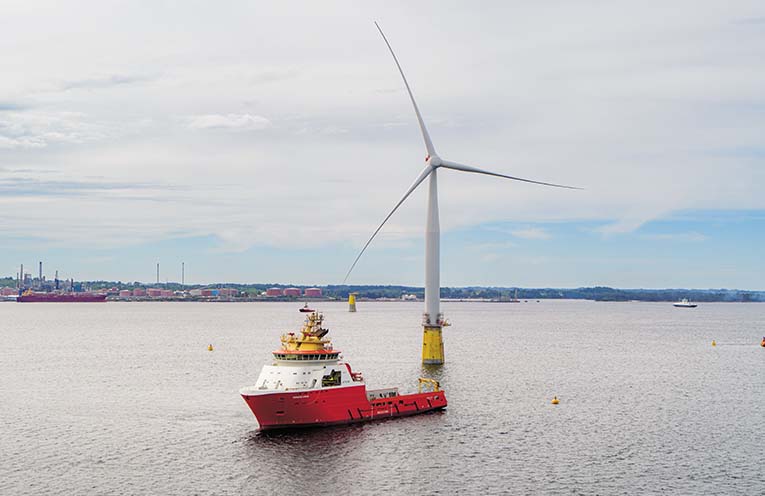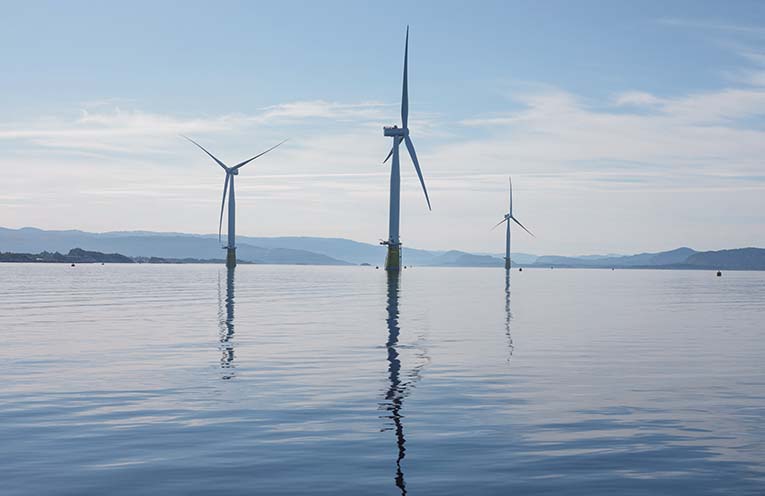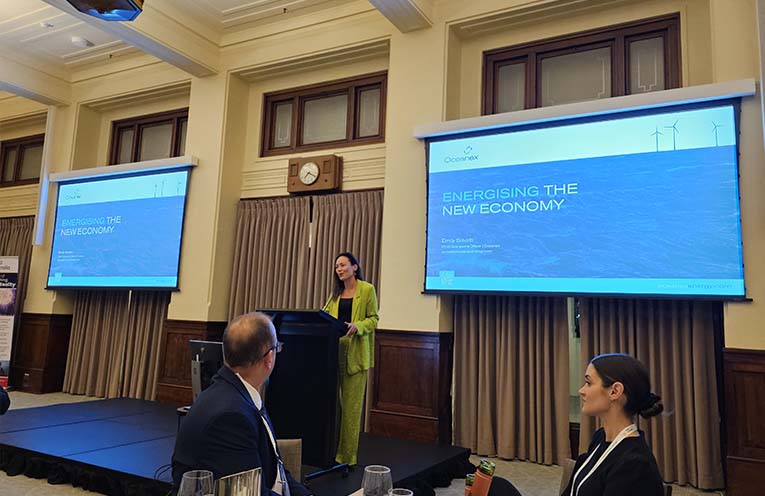
“THIS is about regional prosperity for multiple generations.”
That is how Oceanex Energy COO Emily Scivetti described what she deems the “incredible opportunity” to bring an offshore wind industry to the Hunter region.
Oceanex, in partnership with Equinor Energy, is one of multiple proponents seeking to develop a project in the recently declared offshore wind zone off the Hunter coast.
“Since 2020 we have always led with the opportunity of offshore wind as a new industry,” Ms Scivetti said.
“With the heavy industry that already exists in the Hunter, and the 10,000 jobs that rely on the coal industry, there is a huge opportunity to diversify and transfer skills and workers.”
Oceanex predicts that 3000 jobs will be created during construction of their project alone, with 200-300 jobs ongoing to operate and maintain the wind farm for its 30 year lifespan.
The challenge, according to Scivetti, is creating the local workforce.
“We don’t have the offshore infrastructure or the marine experience that we have on the west coast.
“We have to build an offshore wind workforce.
“That comes from new workers, as well as transferring and diversifying workers from sunset industries.”
If Oceanex, or any other wind farm developer, is granted approval to build a wind farm off the Hunter coast, construction is expected to be at least seven years away.
“There is a whole new skill set to develop and construct offshore wind assets, but there is opportunity in that challenge.
“(Seven years) is a good runway with clear sight as to what those jobs are for us to prepare local residents for the thousands of jobs this construction project will bring.”
Founded in 2020 by offshore wind pioneers Andy Evans and Peter Sgardelis, Oceanex has multiple offshore wind projects underway in Australia and New Zealand.
Norwegian energy giant Equinox Energy will partner with Oceanex on their NSW projects, including the Novocastrian Offshore Wind Farm in the Hunter.
The Novocastrian floating offshore wind farm is forecast to generate 2 gigawatts of renewable energy, similar to the output of the Liddell Power Station.
The Equinor portfolio includes the largest offshore wind farm in the world, Dogger Bank off the coast of England, and the world’s largest floating offshore wind farm, Hywind Tampen in Norway.
Oceanex has been working on their Novocastrian project since 2020 and hopes to apply for a feasibility licence within the declared Hunter offshore wind zone in November.
“If the Minister (Chris Bowen) awards us with a feasibility licence then we can start all the feasibility licence activities.
“That is five to seven years of surveys, studies and campaigns to determine the feasibility of an offshore wind farm.”
The feasibility licence gives a proponent exclusive exploration rights over their patch of seabed.
“Before a final investment decision there are many years of environmental surveys and geotechnical campaigns,” she said.
“We have to measure the wind by floating LIDAR (Light Detection and Ranging) for many years.
“All of these things have to happen for the next phase, which is a commercial licence.”
If, after these studies, the proponent thinks the project is financially viable, and they have approval from the regulator and environmental bodies, they can apply for a construction licence.
“That is the licence where the regulator gives permission to actually build offshore wind farms,” Scivetti said.
In July, the Federal Minister for Energy and Climate Change Chris Bowen officially declared an offshore wind zone off the coast of the Hunter, inviting wind farm developers to apply for feasibility licences until November.
The area put out for public consultation was almost 5000 square kilometres, while the finalised zone is around 1800 square kilometres.
“The government took on board all those community issues around the Gould’s petrel, the visual amenity, Norah Head, Port Stephens and the defence force,” Ms Scivetti said.
“All of the consultation meant that he (Chris Bowen) changed the shape of the declared area.”
Under the Offshore Electricity Infrastructure Act, potential wind farm developers can apply for an area of up to 700 square kilometres within the zone.
“There are really specific guidelines from the offshore regulator, the National Offshore Petroleum Safety and Environmental Management Authority (NOPSEMA), around the evaluation process for proponents,” Ms Scivetti said.
“You are going to be evaluated higher if you can demonstrate efficiencies within a smaller area.
“We would expect, just like we have seen at Gippsland, that many proponents will make submissions for areas of up to 700 sq km.
“We think that a 2 gigawatt floating offshore wind farm will probably occupy between 400-500 sq km in the end.”
At these sizes, and with the Federal Government’s aim to generate up to 5 gigawatts of renewable wind energy off the Hunter coast, it is likely that multiple wind farms will sit within the zone when finalised.
“The regulator is encouraging proponents not just to take up as much area as they can in their feasibility application, but to be optimised and considered in how they submit for a patch of sea bed,” Ms Scivetti said.
“You submit with geo-coordinates which area you seek a licence for.
“You must choose your puzzle piece.
“Depending on how big the puzzle pieces are within the zone, will ultimately decide how many licences are granted.”
From an economic standpoint, Ms Scivetti said projects must generate a gigawatt of electricity to be viable.
“These are large, nationally significant infrastructure projects with capital expenditures of around $10 billion.
“To recoup the investment you need to have large scale energy production, or what we call gigawatt scale generation.
“Typically, you would not see a proponent submit for a farm less than one gigawatt, because of course the more power you generate, the more you sell into the national energy market.”
The declaration of the Hunter offshore wind zone has been met with anger from sections of the Port Stephens community, with concerns raised over the fishing sector, the impact on whales, tourism, the visual amenity and national security, among others.
When it comes to the impact of floating offshore wind farms on the marine environment and species, Ms Scivetti urges patience while studies are carried out during the feasibility licence stage.
“In terms of whale migration, because we have never had assets off the east coast, we do not have any data when it comes to how whales would interact with offshore wind farms off our coast.
“That is why that is one of the key studies we want to start straight away.
“There are no studies on the east coast around sea and migratory birds, so that is another data set that we would need to start really early.
“We need to carry out many years of seasonal surveys to bring to the regulators and the environmental approval authorities.”
Ms Scivetti did concede however, that offshore wind turbines will be visible from the shore, despite the zone moving ten kilometres further out to sea following public consultation.
“You will be able to see offshore wind turbines from the coast,” she said.
“Some days, if it’s not a clear day or the sun is not shining in the right direction, you probably won’t see them.
“There will be a difference to the horizon, there is no getting around that – that is an offshore wind farm.
“However, we do choose sites that are as far from the coast as possible, so 20 to 30 km off the coast is a 260 metre wind turbine.”
Ms Scivetti spoke to News Of The Area from the Global Wind Energy Council’s inaugural APAC Offshore Wind and Green Energy Summit, where Chris Bowen announced public consultation on further offshore wind zones in Tasmania and Western Australia.
The Clean Energy Council, the peak body for the clean energy industry in Australia, said the proposed offshore wind projects have the potential to “provide a windfall for the economy, supporting the growth of local supply chains, jobs, and investment into regional Australia”.
“From transport vessels and ports through to construction support, offshore wind will create approximately 8000 Australian jobs,” a Clean Energy Council spokesperson told News Of The Area.
“There is a need to accelerate these projects to meet renewable energy generation targets
and for the economy.
“However, development of the offshore wind industry must be consistent with the economic, environmental, social and cultural needs of all the other users of the marine environment and neighbouring communities.”
By Doug CONNOR


